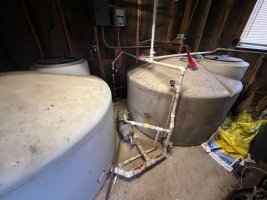Hi All,
Moved to a property about a year ago, we have a well that pumps to 2 storage tanks and a MQ3-45 pumps to 2 separate houses. The Grundfos went out this past weekend and I want to use this opportunity to make the water run smoother (pretty bad pressure drop in the first 2-3 seconds with the Grundfos and no pressure tank).
Parts purchased:
- Goulds J10S (going to be used at 115V)
- PK1A Pside-Kick Pressure Tank Kit w/10 gallon tank
- 1.25" check valve
Attached is an image of the current setup. Not 100% sure about some of the connections, but want make sure the parts above are sufficient/recommended for the goal.
All tips/advice/criticism is welcome and encouraged. Thanks!
Moved to a property about a year ago, we have a well that pumps to 2 storage tanks and a MQ3-45 pumps to 2 separate houses. The Grundfos went out this past weekend and I want to use this opportunity to make the water run smoother (pretty bad pressure drop in the first 2-3 seconds with the Grundfos and no pressure tank).
Parts purchased:
- Goulds J10S (going to be used at 115V)
- PK1A Pside-Kick Pressure Tank Kit w/10 gallon tank
- 1.25" check valve
Attached is an image of the current setup. Not 100% sure about some of the connections, but want make sure the parts above are sufficient/recommended for the goal.
All tips/advice/criticism is welcome and encouraged. Thanks!

